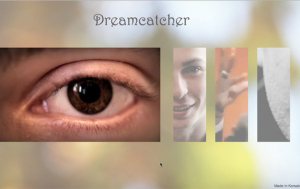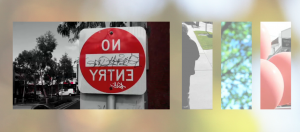It’s funny isn’t it? How we deem ourselves incapable because of an assumed understanding of our capacity… yet it is an untouched capacity… a capacity have yet to experience in its awesomeness. No, instead, we overestimate our understanding of said capacity and underestimate our capabilities. Without our awareness, we put ourselves down into a pit of illusions, illusions which serve only one purpose, and that is to weigh our dreams down and make them unreachable.
Category Archives: Integrated Media
Defying our presumed incapacity to adapt.
It’s really interesting to note this concept of adapting to ones medium. One cannot impose their own characteristics wholly on a medium because it won’t work with you. As Adrian regarded, we don’t see the world in a rectangular frame but we film the world in a rectangular frame. We understand that the medium of the camera presents the world in such a perspective that we must adapt to this feature or else we will fail to use it. We need to work with the tools we are offered. This brings me back to Korsakow and the way in which we feel a need to impose a story on this medium that exists within a different realm to the traditional narrative structure. We need to work with Korsakow to create a film based on patterns, themes, ideas…..
MY SKETCH FILM :)
dog, cat, horse, bird, lion
Class debate: Do lists challenge the continuity of narrative structures?
By definition a list has no ’cause and effect’ change. We have no continuity within it. There’s no sense of causal logic. It’s categorical. We cluster things based on certain similar characteristics.. there is no continuity in that. We do not need narrative as much as we tend to think we do. We can still offer insight into new aspects of the world through a calculated use of categories.
PpPpAAAt-t-t-t-eeEEeeEER.R.R.R.NnnnN(S)
So now we’re getting into the nitty gritty stuff with these K-films. In the process of making mine I’ve tried to think outside the box in terms of potential patterns. I think sometimes I try too hard to make creative patterns that i don’t establish already existing connections between my SNU’s. Think broadly about the associative patterns. Patterns can be created through aesthetic and content material. Snu’s can be grouped on shot size, shot length, angles of camera, themes, similar time of day within the shot etc. The list is infinite; there is always another pattern to be made and even more to be found.
back and forth
Rocking chairs and their indecisiveness. it’s interesting how much a chair can offer insight into someone’s character.
constraint 5.
It’s raining, it’s pouring… I haven’t the intellectual capacity to finish this rhyme.
Being small in a big world.
What does it feel like to be tiny and surrounded by what can only be explained as a multitude of giants trying to crush you beneath their big boat feet??
<<<<<<<<A dog’s perspective.>>>>
constraint 5.
Integrated Media- Sketch Essay (Assignment #2)
A hyper textual framework motivates the structural format of Korsakow Film. Such Films encourage the audience to uniquely engage and extract an interpretation based upon an individualized experience with the database- like film. As Adrian Miles suggests in his ‘Korsakow as Hypertext’ blog (2011), the rules of reading k-films are “the same for hypertext”. Through the tool of the interface, the user can encounter patterns and content material in their own non-narrative based way.
As a subject for my analysis of Korsakow I explored the 2011 K-film, ‘Dreamcatcher’ (Jess Hallay, Michael Serratore, Damien Gould). The film finds its matter in the concept of dreaming. It attempts to recount the erratic nature of dreams through the collective combination of the interface, pattern and content.
The content in a K-film is designed to stray from a ‘cause and effect chain’ but rather, organised in a list-like manner. ‘Dreamcatcher’ organises its SNU’s (Smallest Narrative Unit) into three clusters: A state of total consciousness, a hazy state between wakefulness and sleep, and a dreaming state. I found that the choice to create these three clusters functions well in continually maintaining the theme of dreaming whilst simultaneously making it more associable for the user.This assents to the creator of Korsakow, Florian Thalhofer, who commented regarding the importance of “themes” in Jeffrey Youngs ‘A champion of nonlinear narratives: An interview with documentary filmmaker Florian Thalhofer’ (2014). Each of these categories can be accessed via specific, recognizable SNU’s. That is, the ‘state of consciousness’ cluster is categorised by a close up of an open eye, the ‘hazy stage’ by an eye gradually closing, and the ‘sleep stage’ by a closed eye.
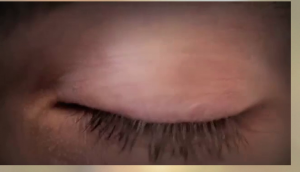
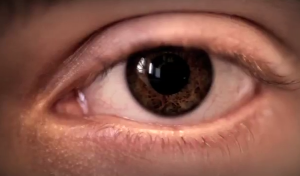 What I find to be effective about these three SNU’s is the pattern created through the framing and associations between them. Each of these SNU’s is a close up on either an eye or a mouth announcing the exact phase the user will enter. Although the verbalisation of the three categories aided in further clarification, I feel they were somewhat superfluous as they announced the clusters too explicitly. The basis of dreaming is in the crazy, fusion of experiences that lack too much clarity. Thus, hearing the three stages contradicts the intended chaotic nature of the piece. Similarly, I found the choice to not use textual aid very clever, as they would provide too much clarity for a film about the confusion of dreams. The content in itself forms patterns that enable us to distinguish between clusters. The state of total consciousness is characterised by human subjects speaking of their own dreams. For instance, a young boy speaks of his dreams regarding making movies with Quentin Tarantino. The intercutting of scenes from Tarantino movies helped in transporting me to the dream itself, thus encouraging a vicarious experience of the dreams themselves.
What I find to be effective about these three SNU’s is the pattern created through the framing and associations between them. Each of these SNU’s is a close up on either an eye or a mouth announcing the exact phase the user will enter. Although the verbalisation of the three categories aided in further clarification, I feel they were somewhat superfluous as they announced the clusters too explicitly. The basis of dreaming is in the crazy, fusion of experiences that lack too much clarity. Thus, hearing the three stages contradicts the intended chaotic nature of the piece. Similarly, I found the choice to not use textual aid very clever, as they would provide too much clarity for a film about the confusion of dreams. The content in itself forms patterns that enable us to distinguish between clusters. The state of total consciousness is characterised by human subjects speaking of their own dreams. For instance, a young boy speaks of his dreams regarding making movies with Quentin Tarantino. The intercutting of scenes from Tarantino movies helped in transporting me to the dream itself, thus encouraging a vicarious experience of the dreams themselves. 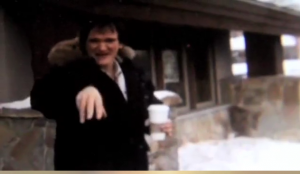
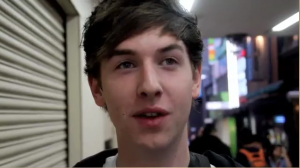 The young boy returns in another SNU to speak of another dream, which I feel enables us to connect with the characters in this film. I found the human subjects gave the piece more warmth and associate. The use of a variety of stories from many different aged and gendered people appeals successfully to different audiences whilst instilling a sense of authenticity to the piece.
The young boy returns in another SNU to speak of another dream, which I feel enables us to connect with the characters in this film. I found the human subjects gave the piece more warmth and associate. The use of a variety of stories from many different aged and gendered people appeals successfully to different audiences whilst instilling a sense of authenticity to the piece.
The interface functions as the point of interaction between the user and the medium. As Korsakow, by nature, lacks narrative chronology in its structure, the interface often reflects this. ‘Dream catcher’s’ interface includes that of a single dominant frame developing from the left-most side of the screen towards the middle point and three ‘sliced’ thumbnails on the right of it.
This interface can be analysed from both an aesthetic perspective and content-based perspective. Aesthetically, the combinations of colours develop a soft-tonal, spring-like ambience that works well with the out of focus background; thus drawing the user’s eyes to the central frame. Furthermore, the placement of the four thumbnails, which are unified by their exact length allows for a strong consistency and gentle, poetic flow that remains throughout the films duration. The interface plays an integral role in the manner in which the user understands the content. Due to the hyper textual basis of the K-film, the filmmaker is at liberty to construct meaning from the combination of both the content and the way in which that content is accessed. In his ‘Dense Nodes’ blog, Adrian Miles discusses the concept of a ‘small world network’, which assumes “lots of a small number of connections between individuals, but with a few individuals who have a lot of connections”. I found the ‘Dreamcatcher’ embodies the nature of a ‘small world network’ in the way the filmmakers have purely one clip with multitudinous connections to others. For instance, it is the open eye clip that leads to all the interviews clips. They form such intricate connections whilst maintaining a proper sense of rhythm through the three categories. As such, every clip is connected to another within the film, without actually having a direct link to it. This, I believe enables a clear holistic understanding as the movie as a whole with an overarching theme of dreams. Although the interface is aesthetically pleasing, the placement of the larger frame followed by three side frames encourages myself as a user, to work through the SNU’s (Smallest Narrative Unit) in a somewhat chronological fashion (from left to right as is the form of the English language). In this sense, the content became narrative- like which distracted from the intended erratic representation of dreams. Another unpleasing element of the interface presides in the lack of looping within the SNU’s. As such, I found it quite jarring when the SNU simply played once. As a result I felt removed from this dream-like world.
Patterns are discernible sequences that exist in all films, enabling the user to creative associative links between content. In ‘Dreamcatcher’, the different content categories are strongly realised by the patterns used within the film. Firstly, from a sound perspective, I found the filmmakers were able to reflect the chaos of dreams whilst simultaneously maintaining a recognisable pattern. Within the ‘total consciousness’ stage, the user hears diegetic sounds of the human subjects speaking within their atmospheric background. For instance, as a mother speaks of her dreams, the user can hear the somewhat disruptive yelling of her young children in the background. I found this gave an amateur feel to the film, which enhanced its authenticity. Similarly, the sleeping phase was discernable through the combination of diegetic (such as street noises and wind) and non-diegetic soundtracks (such as a soft, low tuned electric guitar that accompanies a mid –shot of a tree). 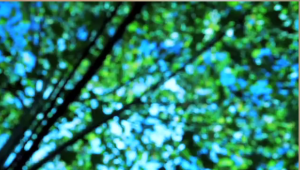
However, I found the ‘falling asleep’ phase to be too similar to that of the ‘dreaming phase’ in terms of the sound pattern, which resulted in confusion as to the shift in clusters. The choice to include both diegetic and non-diegetic sounds in the ‘dreaming’ phase was successful in mimicking the wild and unpredictable nature of dreams. Furthermore, the content was patterned by the aesthetic quality of the SNU’S. While the ‘total consciousness’ stage contained naturalistic lighting reflecting the ‘real world’ quality of the cluster, the ‘falling asleep’ and ‘asleep’ phase contained one unique saturated colour to each SNU, with all other colours drowned out in black and white. For instance, one SNU reveals a stop sign that is a strong saturated red colour with the surrounding trees, street and sky in black and white.
 I found it aesthetically pleasing that these patterns are accentuated by the structural format of the interface, which, in its placement of the four SNU’s beside each other, reveals a combination of different colours that recognise the three clusters. Overall, I found ‘Dreamcatcher’ a strong thematic piece which was both pleasing in its aesthetics and content .
I found it aesthetically pleasing that these patterns are accentuated by the structural format of the interface, which, in its placement of the four SNU’s beside each other, reveals a combination of different colours that recognise the three clusters. Overall, I found ‘Dreamcatcher’ a strong thematic piece which was both pleasing in its aesthetics and content .
unification of the individual experience.
Most interactive documentaries are individual experiences…well actually.. no. I don’t think it’s as simple as that. Although i think the use of the medium itself is a unique and subjective experience however, as Jasmine suggests, ” themes by nature have a universal appeal”. Even though our physical interaction with the tool is relational, we are unified as an audience because of the subject matter…..
